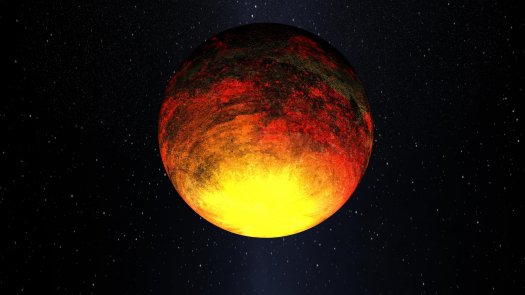
The Kepler telescope team announces a trove
By Rebecca Boyle Posted 02.02.2011 at 12:12 pm 5 Comments
Kepler 10b Closeup NASA
Updated: Scores of Earth-like planets orbit sun-like stars scattered throughout the Milky Way, NASA scientists said today. This morning, the agency released data on more than 1,000 new exoplanets, and early indications are that 54 of them are at just the right distance from their stars to harbor life as we know it.
Today’s results more than double the exoplanet-candidate population, bringing the number of planet candidates identified by Kepler to 1,235. NASA needs to conduct follow-up observations to be sure their candidate planets are actually planets. So far, they are certain about 15 of them.
“The fact that we’ve found so many planet candidates in such a tiny fraction of the sky suggests there are countless planets orbiting sun-like stars in our galaxy,” said William Borucki of NASA’s Ames Research Center in Moffett Field, Calif., the father of Kepler and its principal investigator.
Small, Earth-like planets are apparently more common than gas giants like Jupiter, according to today’s announcement. Sixty-eight of the new planet candidates are approximately
Earth-size, and another 288 are super-Earth-size; 662 are Neptune-size; 165 are the size of Jupiter and 19 are larger than Jupiter, NASA said.
NASA said today that 54 planet candidates are in their stars’ Goldilocks zones — not too hot, not too cold, not too far, not too old — which means they might have liquid water, and therefore a key ingredient for life. Of those 54, five are near the size of Earth. Pretty stunning news when you think about it: In one tiny slice of the sky, scientists have found five other planets that may very well resemble our own.

There is our Solar System that is generated by our Sun. Our Sun’s influence graviitates to it a set of planets, stars, moons and cpmets. Then there is the greater Universe that many solar systems travel, this includes our solar system as well. What I am sayiing here is that we travel in a set cycle that we are familar….i.e. the constellations and comet rotations. However we also travel in a cycle of infinity…where all that we see is new. I am going to need to draw this out. However in a nutshell, we will always see somethng new in the skys like what you are noticing here.
There is our Solar System that is generated by our Sun. Our Sun’s influence graviitates to it a set of planets, stars, moons and cpmets. Then there is the greater Universe that many solar systems travel, this includes our solar system as well. What I am sayiing here is that we travel in a set cycle that we are familar….i.e. the constellations and comet rotations. However we also travel in a cycle of infinity…where all that we see is new. I am going to need to draw this out. However in a nutshell, we will always see somethng new in the skys like what you are noticing here.